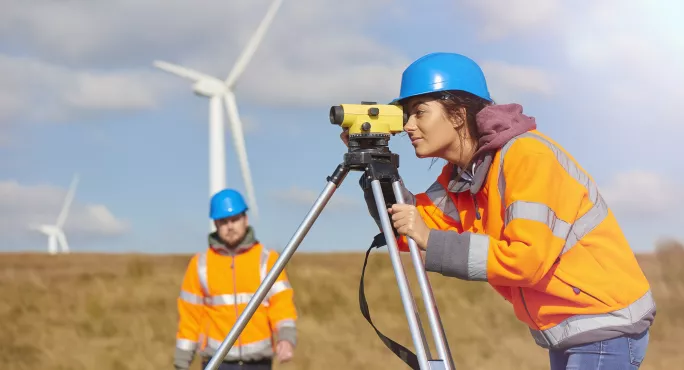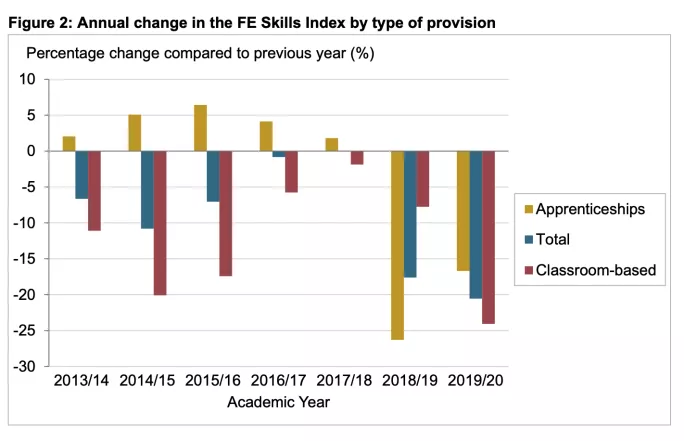Skills Index 2021: What you need to know

The number of learners who achieved a classroom-based further education course or an apprenticeship in 2019-20 was less than half (47 per cent) what it was in 2012-13, and around 21 per cent lower than in 2018-19, according to the latest Further Education Skills Index.
The skills index is published each year by the Department for Education and shows how the aggregate value of the skills supplied by the FE system has changed over time. The index states the downward trend since 2012-13 has mainly been driven by a decline in FE learner numbers, which then has led to fewer achievers.


Other findings
- The number of achievers in 2019-20 was also impacted by Covid-19 restrictions, with disruptions to exams and breaks in learning leading to fewer achievements than would normally have been expected. Achievements in apprenticeships and classroom-based learning fell by around 21 per cent in 2019-20.
News: Apprentices need a pay rise, say MPs
More: We can’t allow remote working to harm apprenticeships
Apprenticeships: Over 1m learners search for vacancies
- Until 2015-16, the decrease was largely driven by a fall in learners achieving classroom-based qualifications. The Skills Index then remained broadly unchanged between 2015-16 and 2017-18, when the number of achievers stabilised. Since 2018-19, a large drop in apprenticeship achievers has contributed to the steeper fall.
- The value added per learner was 6 per cent greater in 2019-20 than it was in 2012-13, suggesting that learners across FE have shifted towards more valuable qualifications (particularly towards apprenticeships, which typically have higher returns than classroom-based training).
- The total value added for apprenticeships increased every year from 2012-13 to 2017-18 but fell by 26 per cent in 2018-19 and by a further 17 per cent in 2019-20. This was mainly driven by changes in the number of apprenticeship achievements, which increased by 10 per cent between 2012-13 and 2016-17 but fell by 47 per cent since 2017-18.
- Achievements in intermediate and advanced apprenticeships have fallen sharply since 2017-18, while the number of higher apprentices has increased.
- The decline in apprenticeship achievements is due to various factors including: a fall in intermediate apprenticeship starts since 2014-15 and also in advanced apprenticeship starts, which fell from 2016-17 to 2017-18 and again in 2019-2020.
- The duration of apprenticeships is increasing, so there are fewer achievements in the short term.
- In 2019-20, an increase in the number of breaks in learning owing to Covid-19 has had a further impact on achievement rates.
- The total value added for classroom-based training has decreased by 62 per cent since 2012-13. It fell by 24 per cent between 2018-19 and 2019-20, its steepest fall to date, driven by a large decrease in the number of achievements at full level 2 and full level 3.
- In 2019-20, achievement numbers were further impacted by Covid-19, which disrupted exams and assessments, and caused a significant increase in breaks in learning and withdrawals.
- In 2019-20, apprenticeships contributed 50 per cent of the total value-added of the FE system even though they represented only 16 per cent of achievements, because apprenticeships generally result in higher returns, higher employment, and higher earnings than classroom-based qualification at the same level.
- The contribution of apprenticeships towards the total value added increased from 34 per cent in 2012-13 to 53 per cent in 2017-18, when apprenticeship achievements were rapidly increasing. Their contribution has fallen back slightly to 50 per cent in 2019-20, when achievements were falling.
- The contribution of higher apprenticeships has gradually increased, from 0 per cent in 2012-13 to 9 per cent in 2019-20, as the number of achievers increased more than tenfold.
- The contribution of classroom-based full level 2 training has decreased from 34 per cent in 2012-13 to 20 per cent in 2019-20, as the number of achievers fell by 71 per cent.
Register with Tes and you can read two free articles every month plus you'll have access to our range of award-winning newsletters.
Keep reading with our special offer!
You’ve reached your limit of free articles this month.
- Unlimited access to all Tes magazine content
- Save your favourite articles and gift them to your colleagues
- Exclusive subscriber-only stories
- Over 200,000 archived articles
- Unlimited access to all Tes magazine content
- Save your favourite articles and gift them to your colleagues
- Exclusive subscriber-only stories
- Over 200,000 archived articles